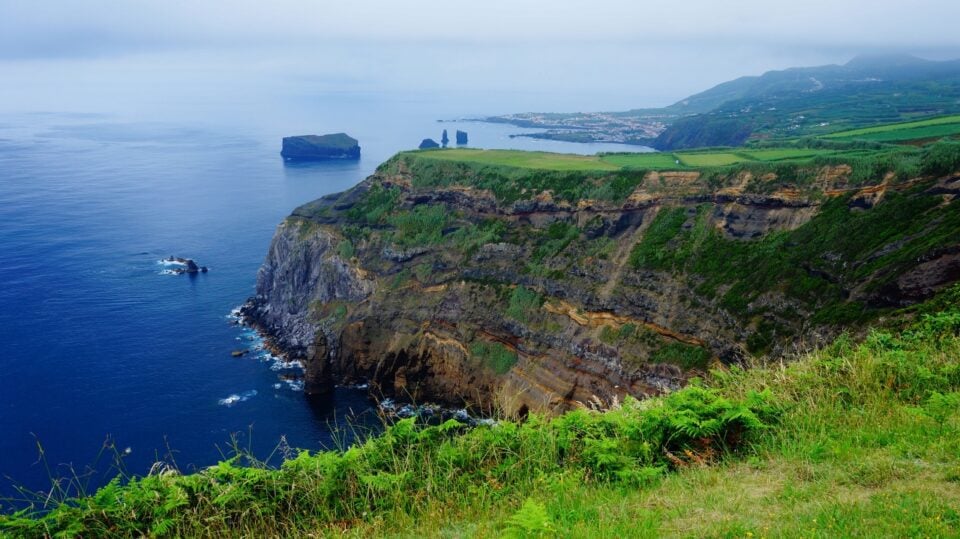The Azores Islands are an archipelago in the Atlantic Ocean, on which the autonomous region of Portugal of the same name is located.
The archipelago consists of 9 islands with a total area of 2,322 km². The largest island is Sao Miguel, and it is here that the capital of the autonomous region, Ponta Delgada, is located. Pico Island is famous for being home to the highest point not only of the archipelago, but of all of Portugal: the active volcano Pico (2,351 m).
The Azores are home to almost 243,000 people. The majority of the population is Portuguese, with a small number of Spaniards and French.
The main language spoken in the Azores is Portuguese, but the local dialect differs significantly from the dialects found in other parts of Portugal.
Tourism, government jobs, fishing and agriculture are the main industries in the Azores. The fertile soil provides a variety of crops, vineyards and pastures for livestock.
Interesting facts about the Azores

- There are tea and pineapple plantations in the Azores. Some of the leaves and sweet fruits are exported, and the bulk of the harvest satisfies the needs of the local population.
- The highest point in Portugal is located on the Azores archipelago – this is the summit of the Pico volcano – 2351 meters above sea level. Another 6098 m of the volcano is submerged in the ocean.
- The Azores were described in detail in a Catalan atlas compiled and written in 1375, but the islands were officially “discovered” in 1431 by Gonçalo Velho Cabral. São Miguel was first inhabited in 1444.
- Azorean handicrafts, including blue and white ceramics, woven baskets, fig tree heart miniatures and fish scale flowers, are popular purchases among visiting tourists.
- Writer Mark Twain visited the city of Horta in 1867 during his “Great Pleasure” cruise to Europe and the Holy Land aboard the ship Quaker City with a group of Americans. Twain humorously described his trip, including his time in the Azores, in his book The Innocents Abroad, published in 1869.
- The United States maintains a NATO air base on Terceira Island. Lajes Air Base provides strategic mid-Atlantic connectivity for the United States and allied forces to Europe, Africa, and the Middle East. Lajes Field is a multi-purpose airfield that hosts a Portuguese Air Force base, a U.S. Air Force detachment, and a regional passenger terminal.
- There are no poisonous animals or plants in the Azores.
- Before humans settled on the islands, there were no land mammals, but today the Azores in Portugal are home to mice, rats, hedgehogs, rabbits and weasels.
- The population of the smallest island of the archipelago, Corvo, is only about 500 people.
Entertainment in the Azores
The Azores Islands of Portugal are considered somewhat unique: there is not a single factory here, and virgin nature has been preserved. Ecotourism, active recreation, and water extreme sports lovers come here: trekking, diving, surfing, and hiking. Due to the large number of good beaches, these islands are also perfect for beach holiday lovers.
Fishing
One of the most popular activities in the Azores is ocean fishing, and the ideal places for it are considered to be the waters between Flores, Faial, São Jorge and Pico.
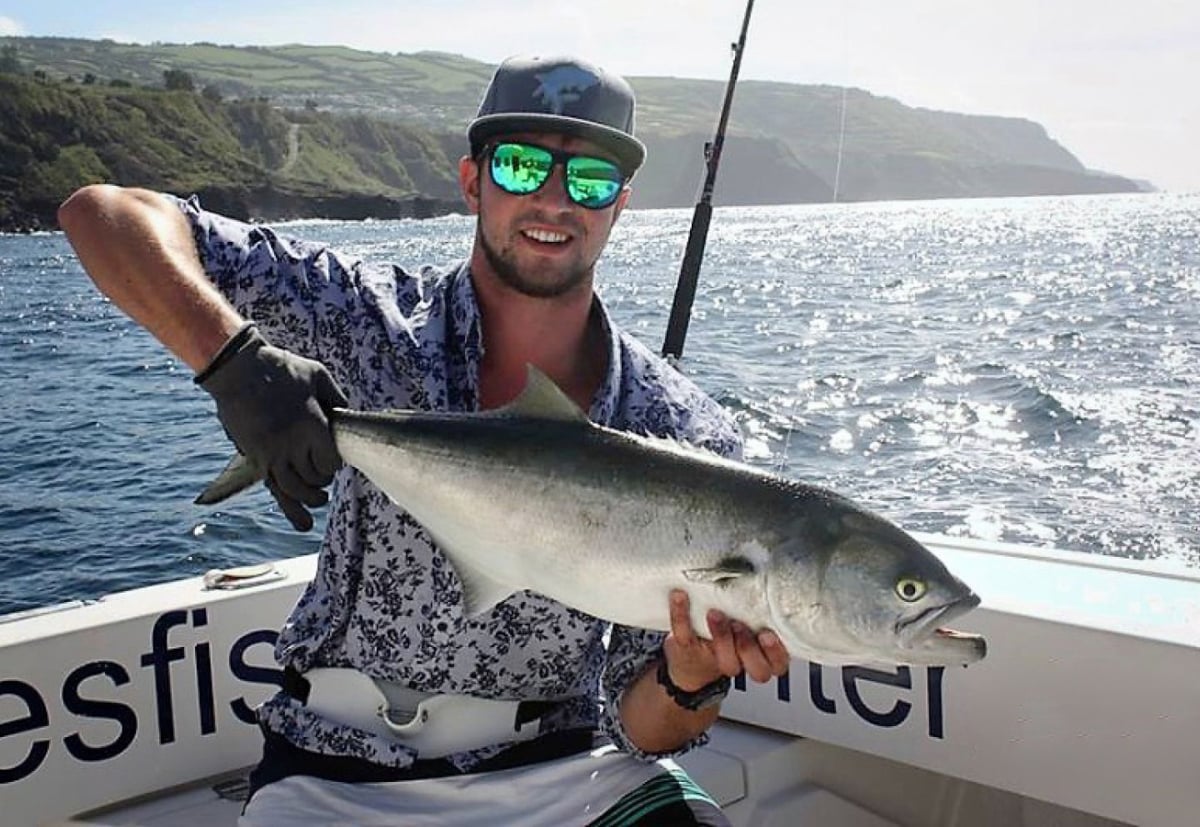
Almost every local travel company can organize such a tour, although you can simply rent a boat or yacht with the necessary equipment and go fishing yourself.
The best time for ocean fishing in the Azores archipelago is July, August and early September.
Whale watching
The world’s largest whale habitats include the waters of the Azores Islands.
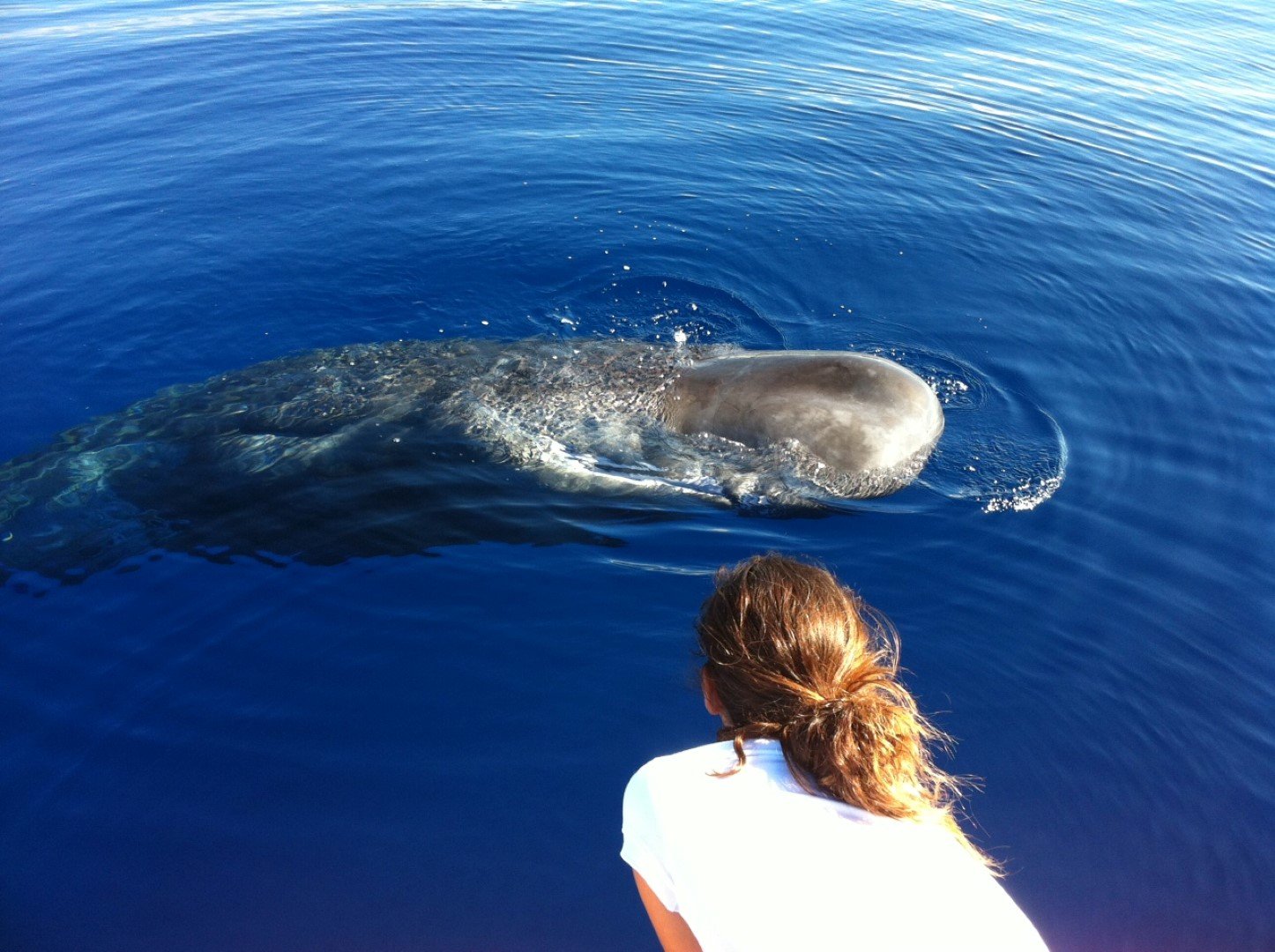
Anyone wishing to get the most out of their stay on the archipelago can go out on a small boat into the ocean and watch whales in the wild. As a rule, the boat gets quite close to the whales – so close that you can feel the whale’s breath and take great photos.
Whale watching is completely safe, you just need to follow the captain’s instructions.
The best time for whale watching in the Azores is considered to be spring (March to early May) and autumn (second half of September).
Beach holiday
The archipelago was formed as a result of volcanic activity, so most of the local beaches are covered with solidified lava. However, on the islands of Santa Maria, Faial and Sao Miguel there are beach areas with black and even light sand.

Most of the beaches are concentrated on the island of Faial, and almost all of them are covered with black sand. The exception is the picturesque Porto Pim, where the sand is light. Castelo Branco, surrounded by rock formations, and located at the foot of the Comprido volcano are good for relaxation. The secluded Praia de Pedro Miguel is ideal for a romantic, serene holiday. The liveliest of all the beaches, where various concerts and performances are organized in season, with a huge number of bars and restaurants along the coast, is Praia do Almoxariffe.
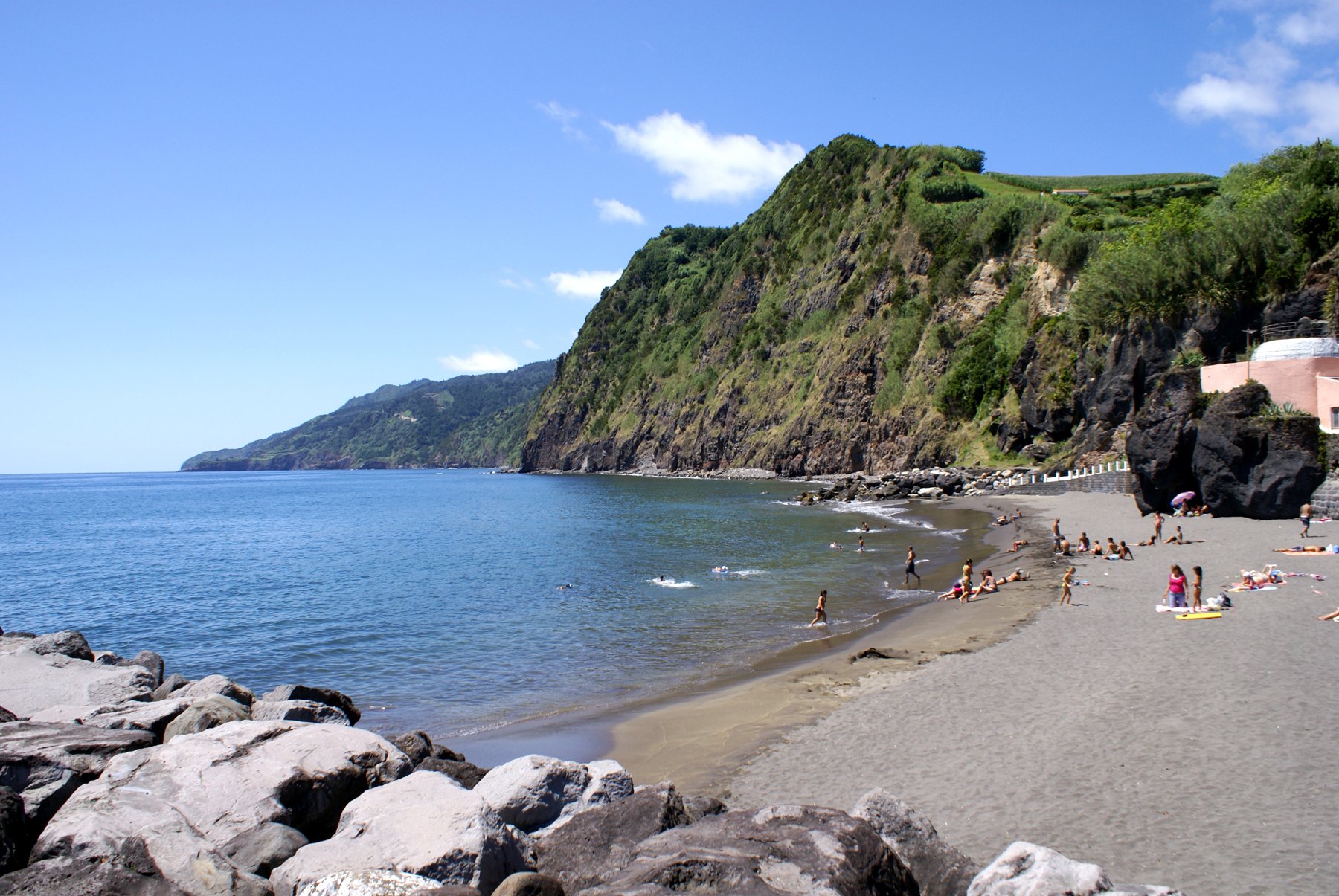
There are also beaches on the island of Sao Miguel. The most picturesque beaches of the Azores, especially popular among surfing fans, are located in the village of Ribeira Grande.
What to see in the Azores archipelago
Each island is interesting and attractive in its own way. Each of them is a unique natural attraction with volcanic craters, volcanic lakes, waterfalls, healing springs, parks. To see all the best of the Azores, one trip will not be enough. In any case, you will have to make a choice of what you must visit. So, the TOP-10 most interesting attractions of the archipelago, most of which are concentrated on the island of Sao Miguel.
The extinct volcano Sete Cidades
Traces of volcanic activity are very clearly visible on Sao Miguel. For example, just 10 km from Ponta Delgada there is a unique local landmark: the huge crater of the inactive volcano Sete Cidades with a lake of the same name located in it. Lake Sete Cidades looks like two separate bodies of water with water of different shades (blue and green), and is popularly called the Blue and Green Lakes.
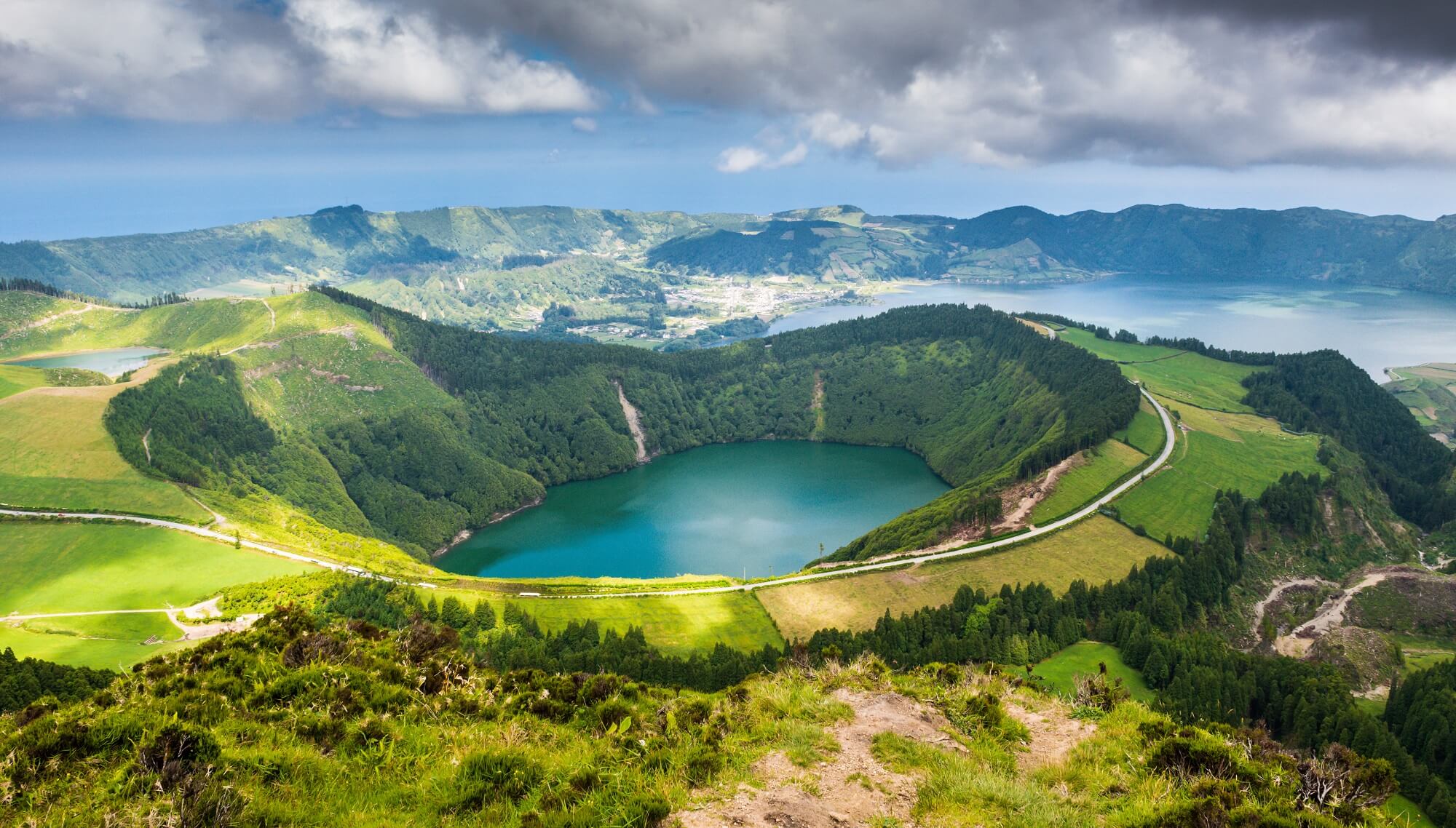
The most stunning view of the crater and twin lakes of Sete Cidades, recognized as one of the most unusual attractions in Portugal, opens from the observation deck Miradouro da Boca do Inferno. From it you can also see the cave through which the entrance to the Boca do Inferno Bay with the waves crashing against it opens. From the platform, from different angles, you can take many amazing photos of the unique attraction of the Azores. Entry to the platform is free, no restrictions.
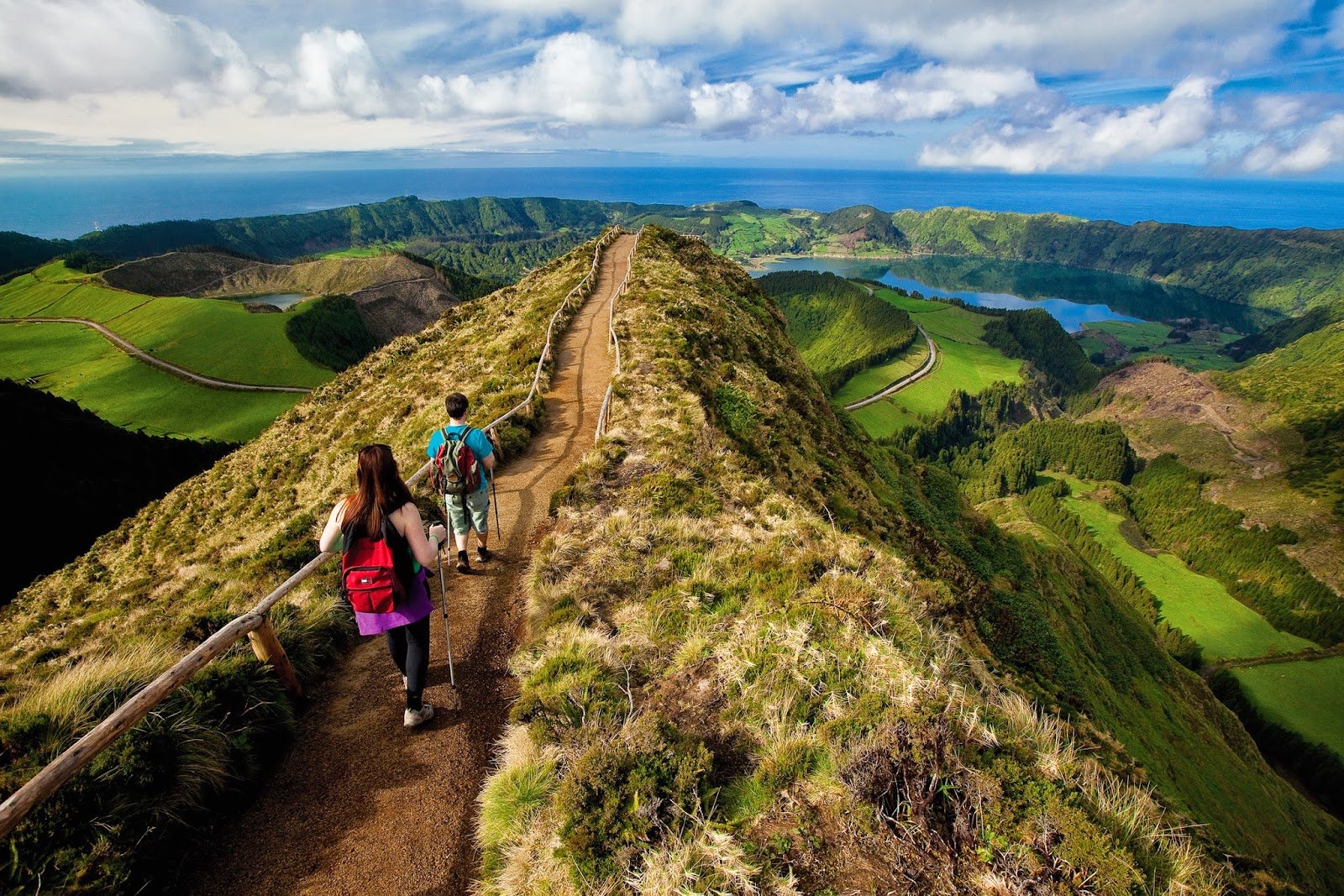
Behind the site there is an abandoned hotel building, many people climb up to its roof and look at the area from there. There are several restaurants nearby, a small parking lot, and a public toilet.
Lake of Fire
The second most beautiful landmark of the archipelago after Sete Cidades is the Fire Lake. It is located on the way from Ponta Delgada to Sete Cidades.
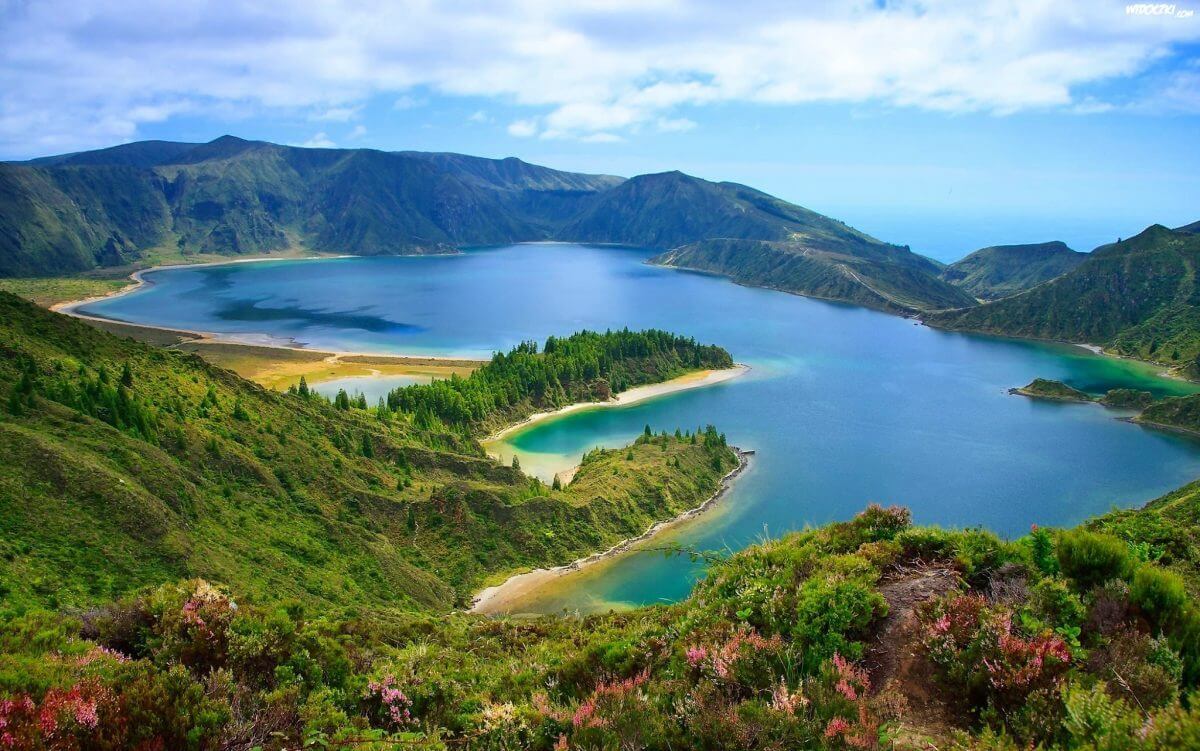
Lagoa do Fogo can be seen even from the road, along which there are several small viewing platforms. Having left the car by the road, you can walk down to the water itself – the trek is simple and will take about 25 minutes.
The water is warm and crystal clear, there are small beaches. The area is “wild”, not equipped at all, everything is absolutely free.
Terra Nostra Gardens
The huge and amazingly beautiful park area of Terra Nostra is another attraction of the Azores on the island of Sao Miguel.
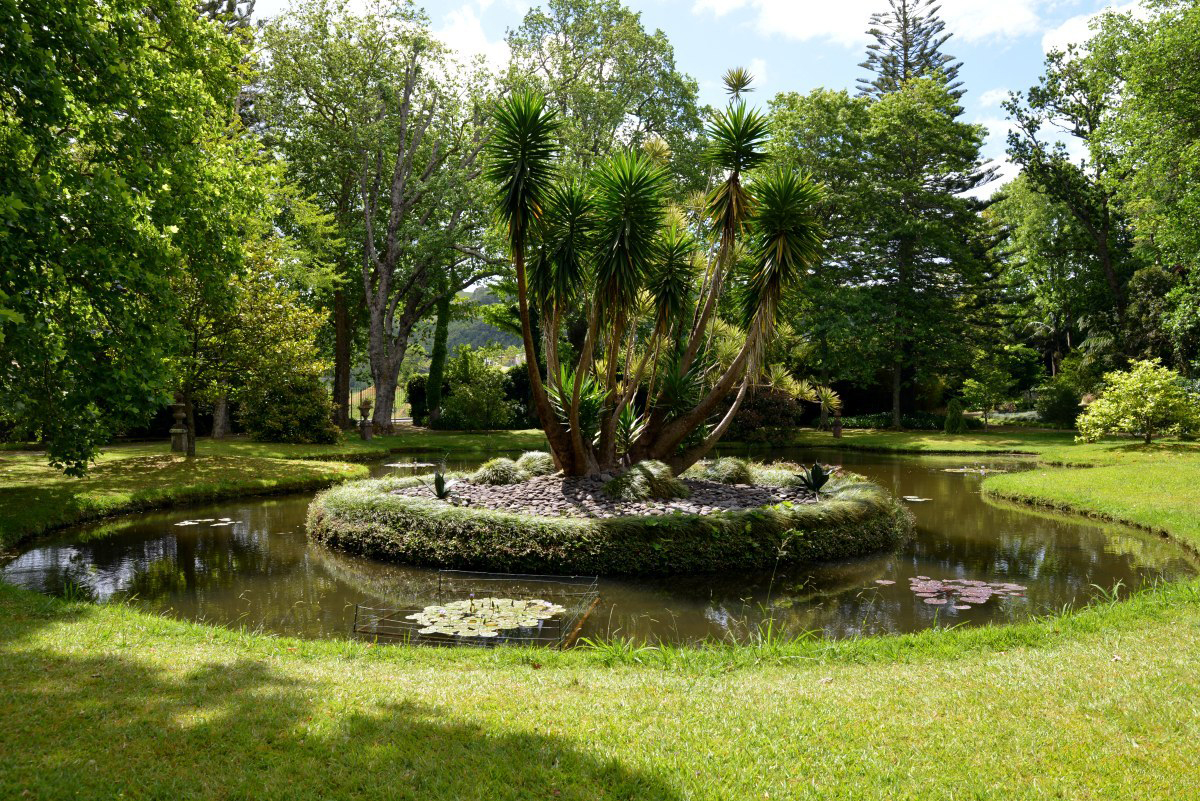
Terra Nostra has a Botanical Garden (one of the best in Portugal) and Thermal Baths. Entrance fee: €20 for adults, €5 for children aged 3 to 10.
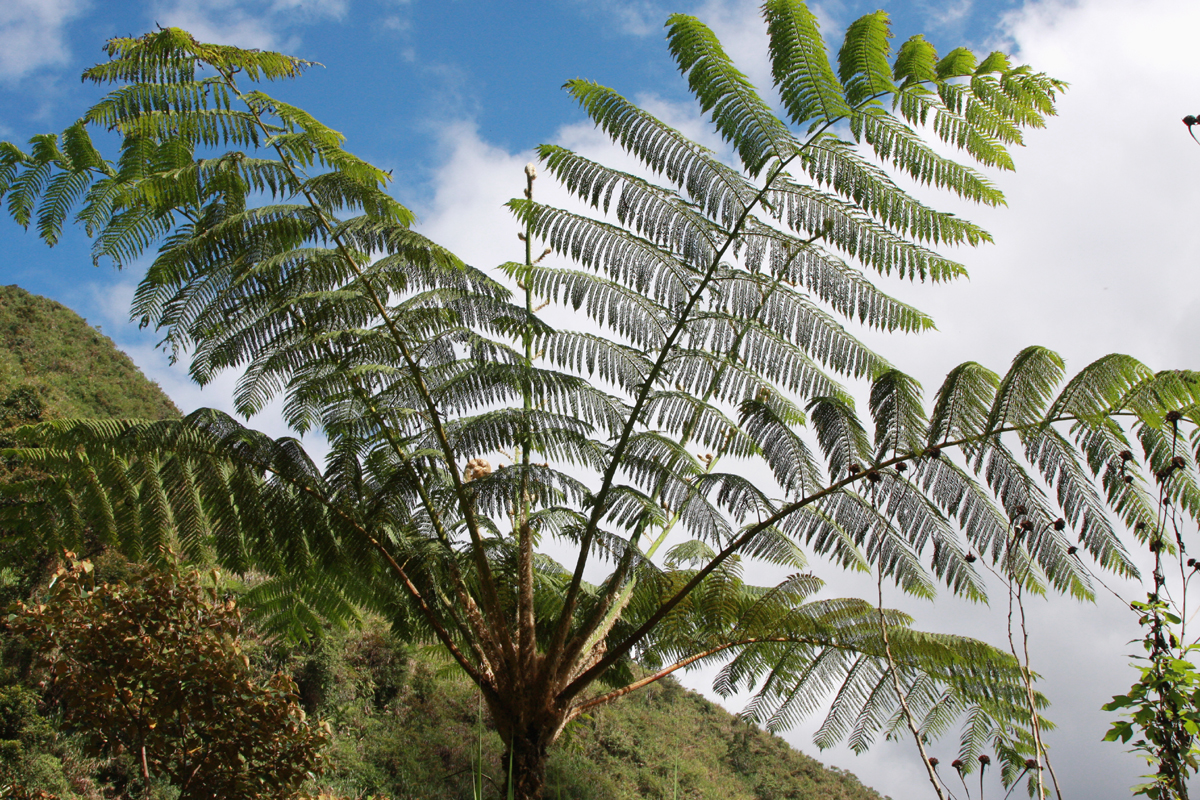
The botanical garden, one of the largest in Portugal, has many unique plants. But perhaps the most amazing of them are the giant tree ferns that look like small palms. The garden is home to white and black swans, ducks – both common mallards and shelducks, mandarins. The territory has many winding paths leading to ancient bridges, mysterious grottoes, beautiful sculptures.
The local landmark is the Thermal Baths, the water of which contains a large amount of iron and is heated to + 40 °C. Scientists have proven that this water, colored brownish-sandy, has a rejuvenating effect. There are changing rooms and a shower next to the outdoor pool, and towels can be rented for an additional fee.
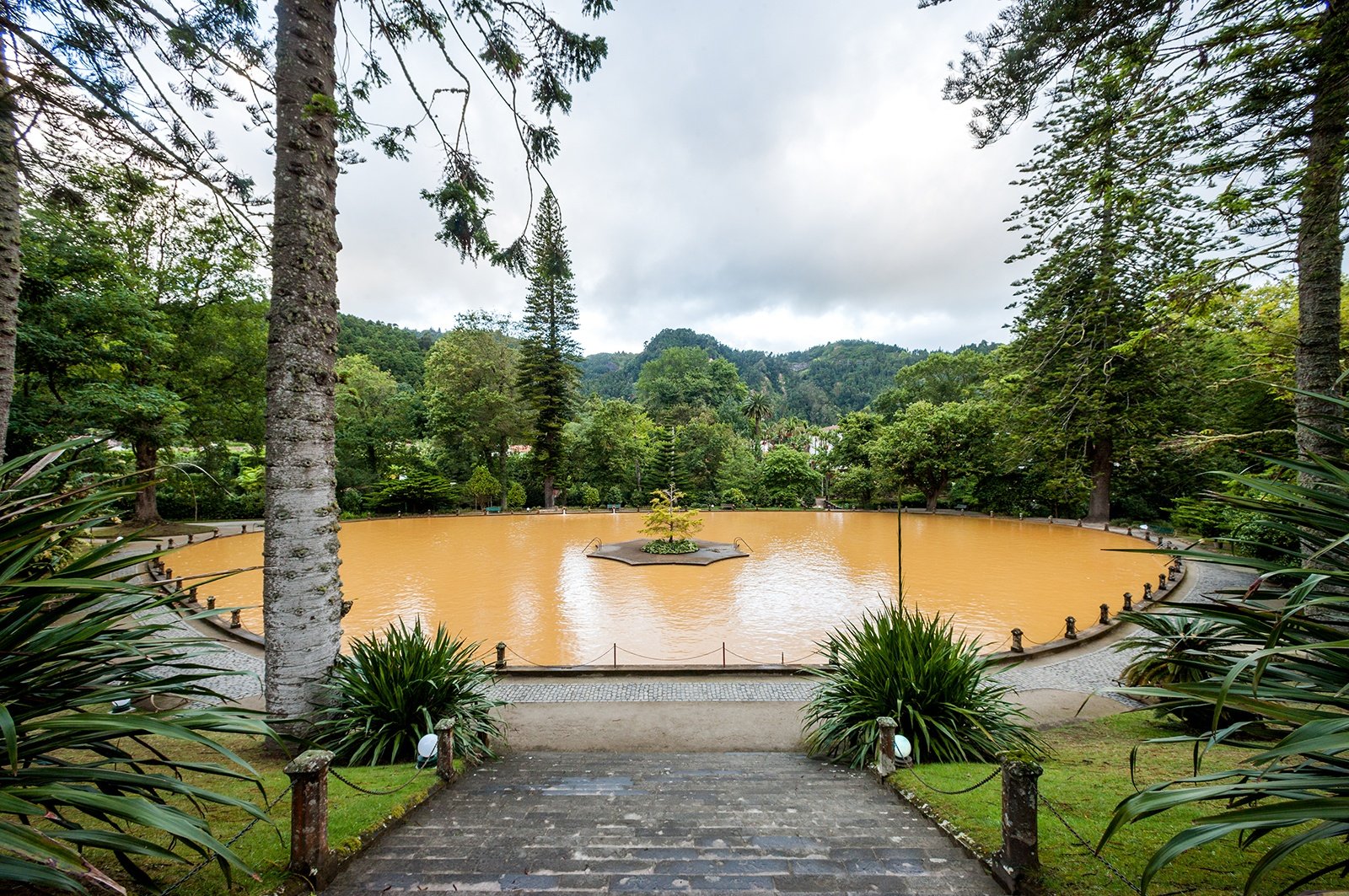
The pool with thermal water is located very close to the entrance to the Terra Nostra park area.
Thermal Baths of Poca Da Dona Beija
The thermal baths with a very pleasant name (Poca Da Dona Beija translates into English as “Little Lady’s Kisses”) are a great place to relax after exploring the local attractions. The water here, although containing a large amount of iron, is much clearer than in Terra Nostra.
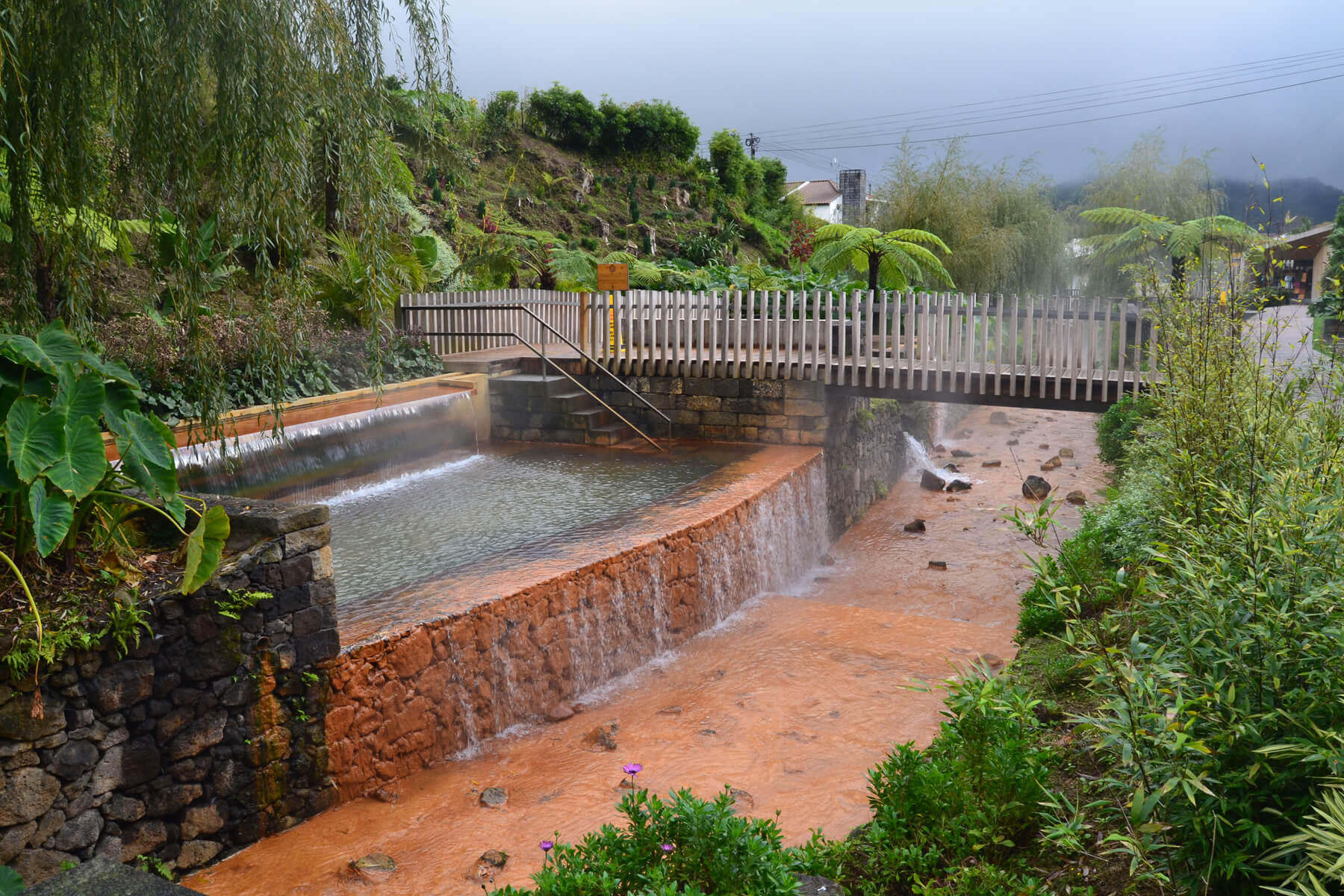
Exact coordinates : Lomba das Barracas, Furnas, Povoacan, Sao Miguel 9675-044, Portugal.
The working hours are very convenient: daily from 7:00 to 23:00. There is a small free parking lot nearby.
Entrance to the Thermal Baths for adults is €8, for children under 6 – €6. You can rent a safe for €2, and a towel for €4.
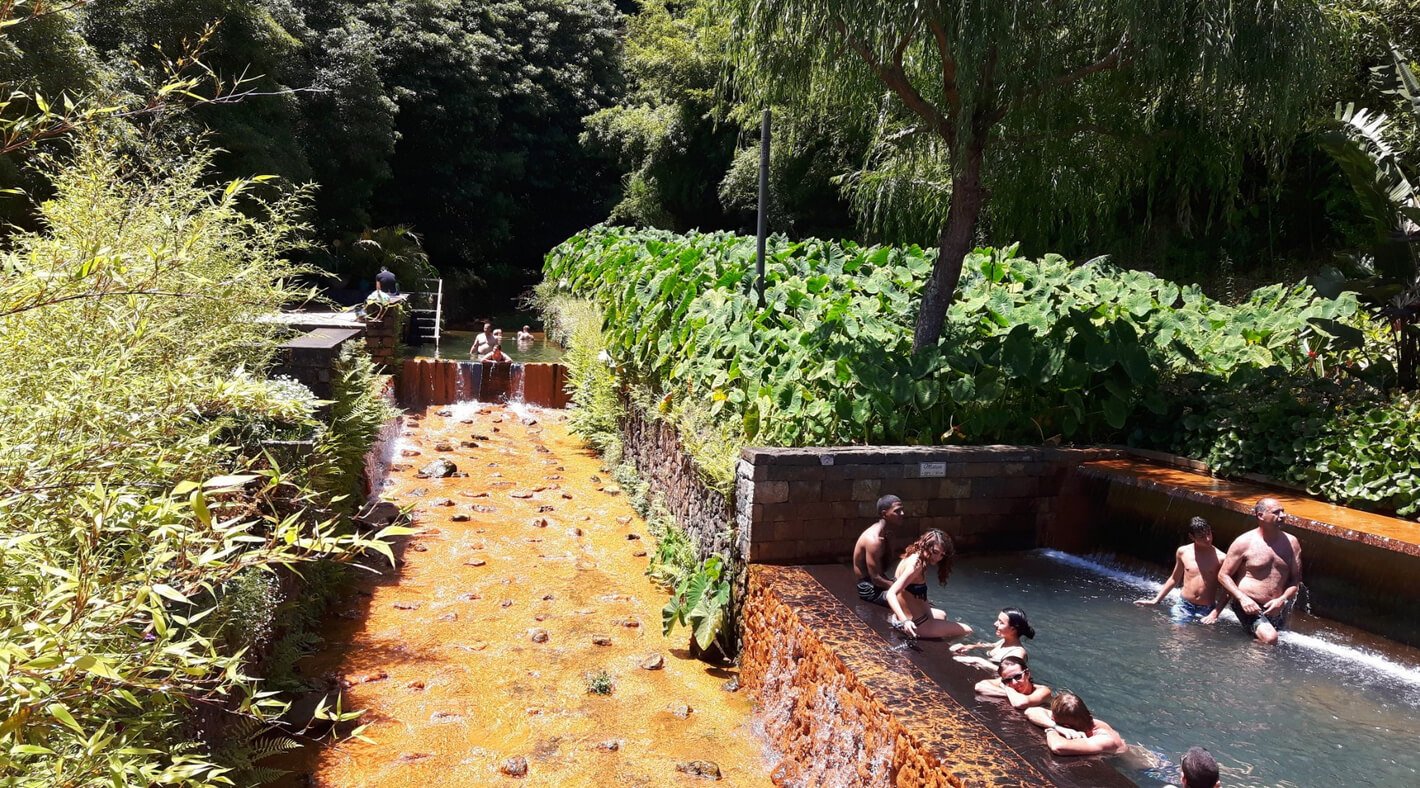
Inside, everything is very modernly decorated. There are changing rooms and a toilet (free to use), and there is a paid shower.
The most important thing is the pools. In the shallowest and farthest one the temperature is +29 °C, in the other 4 the temperature is +39 °C. The depth in the pools is different: from 90 to 180 cm.
Salto do Prego Waterfall
Another must see in the Azores is the main attraction on the island of Sao Miguel. We are talking about the Salto do Prego waterfall, coordinates of which are : Faial da Terra, Povoação, Sao Miguel, Portugal.
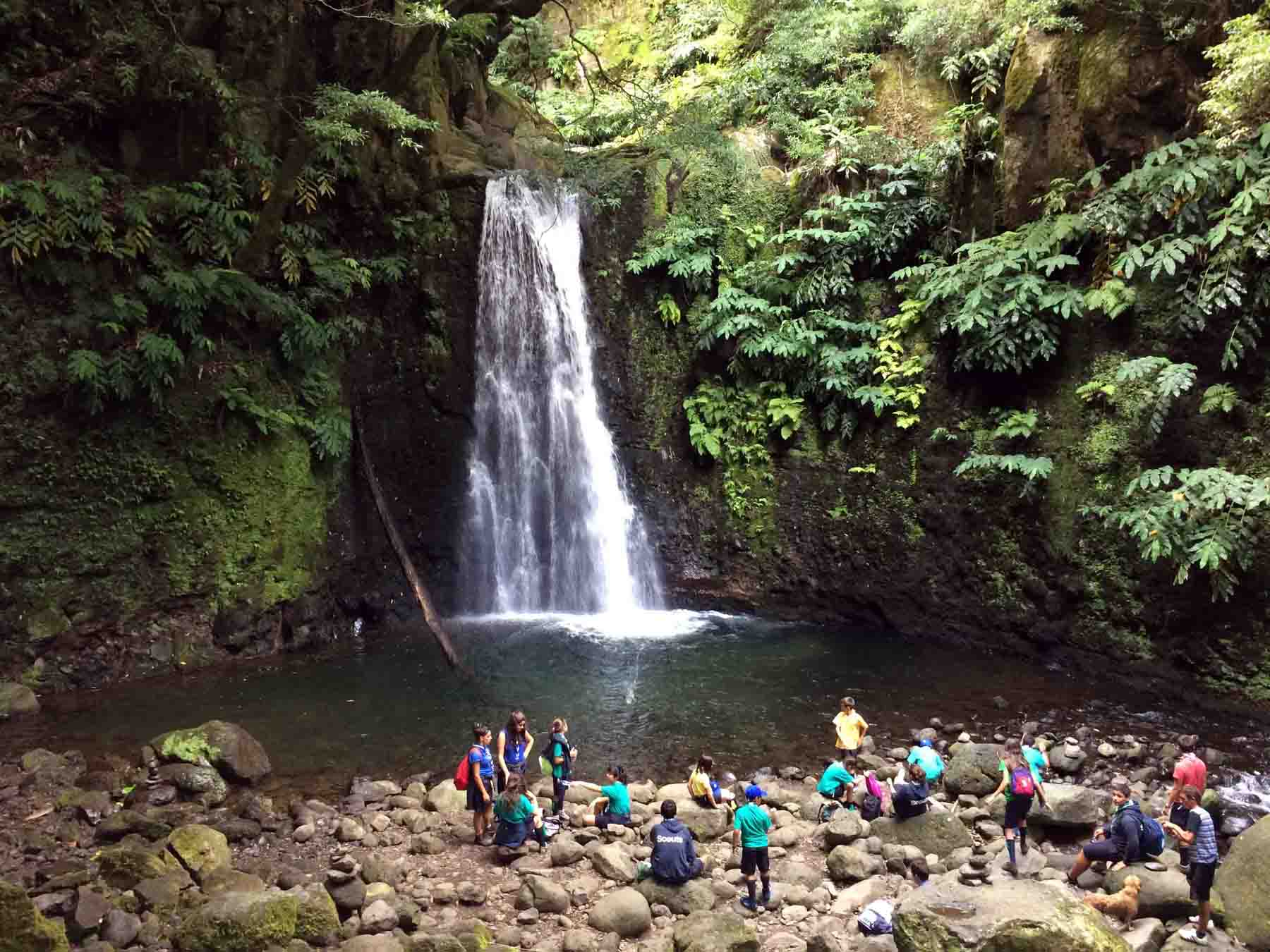
The route to the beautiful, high and quite strong Salto do Prego starts in the village of Sanguinho. The walking trail goes along low hills, through the forest and several villages, along the way there are small waterfalls. The route, pleasant and easy, is suitable for people of all ages, but comfortable shoes are required.
Mount Pico
Nature lovers should definitely visit Pico Island, whose main attraction is the active volcano of the same name. Montanha do Pico (2351 m) is not only a landmark of the archipelago, but also the highest point in Portugal.
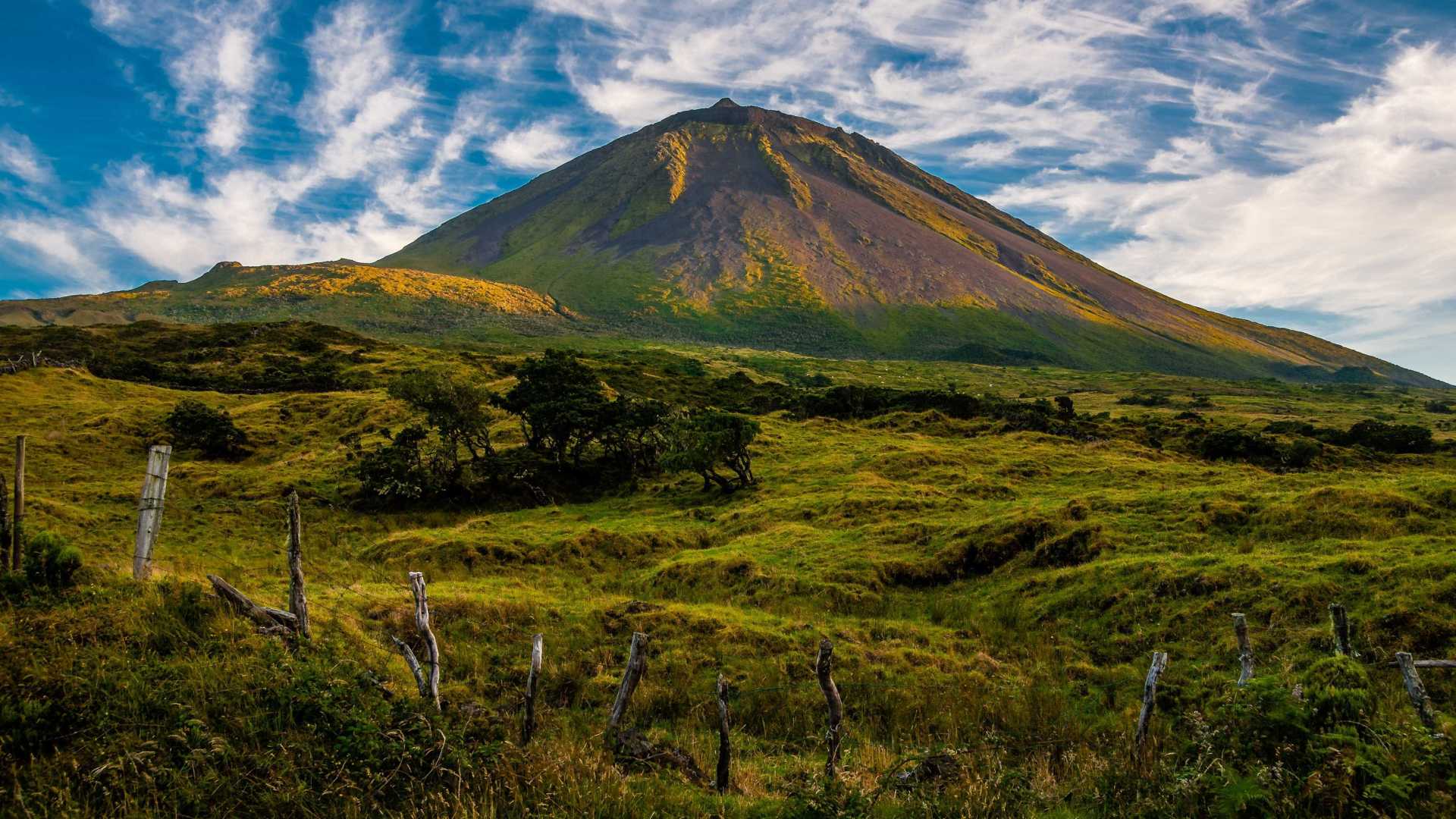
Climbing Mount Pico during a tour of the Azores is one of the most exciting adventures.
To climb, you need strong sports shoes, otherwise you will not be allowed onto the official trail. Since the mountain is windy and often foggy, warm clothes and a windproof jacket will come in handy. You should take gloves and walking poles with you to help you move. You should also take food and a few liters of water.
You can get to the starting point, where the ascent begins, by taxi. A trip from the nearest cities will cost 45-50 € for a “minivan” designed for 6-7 passengers.
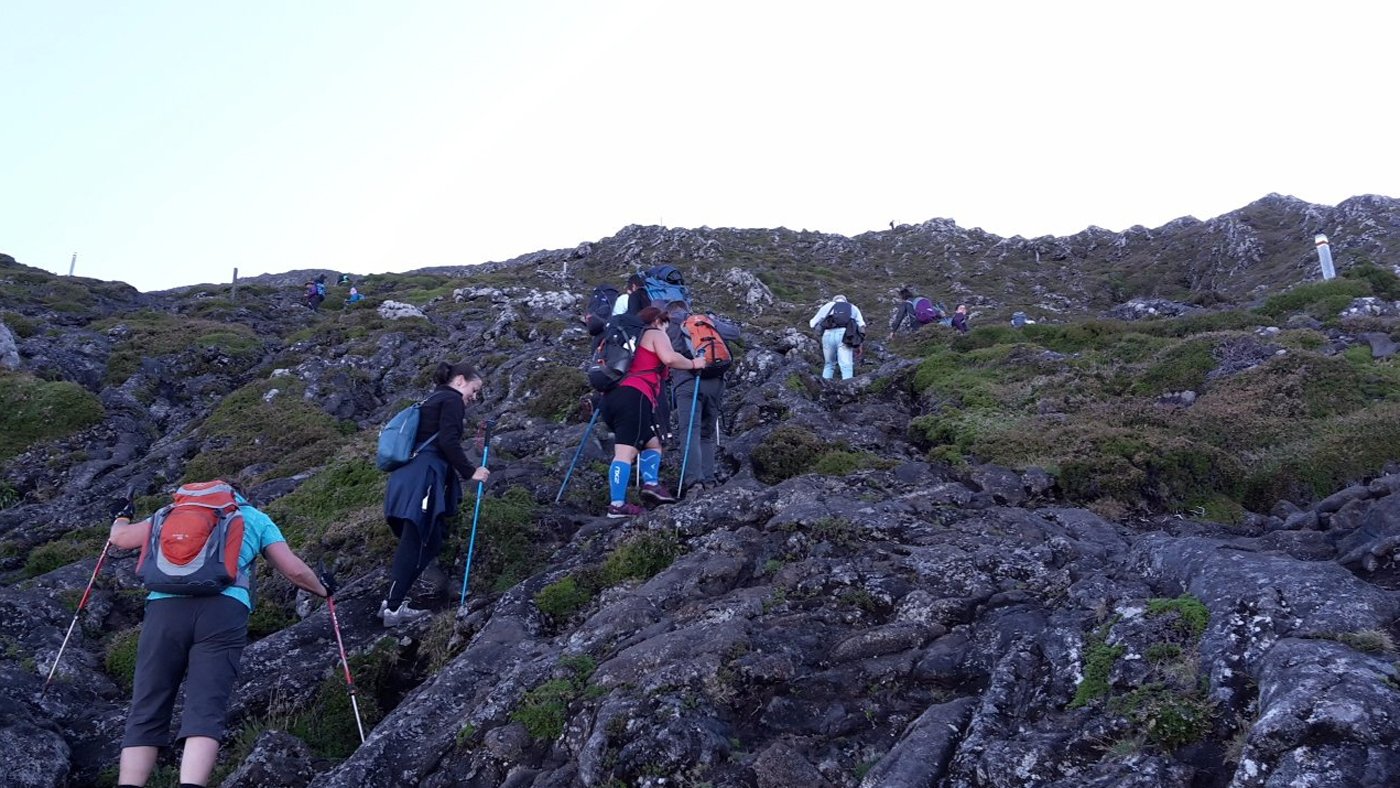
It is better to arrive early, if possible, before sunrise. Noon is the latest time. For people with poor physical fitness, the climb to the top of the volcano and the descent from it will take 7-8 hours, so it is better to devote a whole day to getting to know this landmark of Portugal.
Upon arrival, you must register at the Tourist Assistance Center, undergo safety instructions, receive a GPS navigator and a phone “in one package,” and pay for the ascent. The ascent to the crater costs €10, and the ascent to the summit itself costs €12.
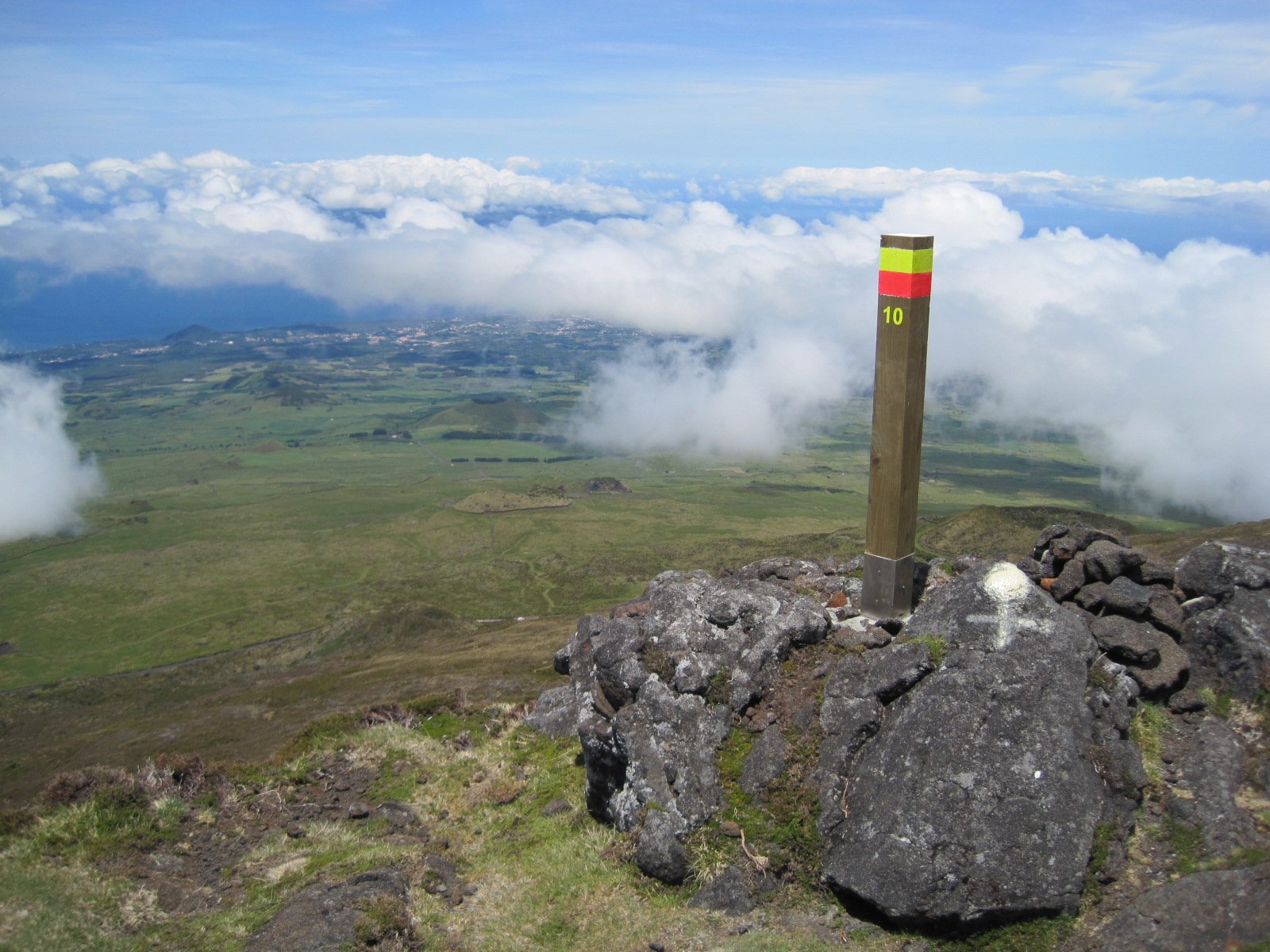
Along the entire trail there are posts numbered from 1 to 45, which should help you navigate the way. Between posts #1 and #2 there is quite a long distance, then the posts become more frequent. The most difficult section of the path, where the mountain is steepest, is between marks #7 and #25. After post #34 the slope of the mountain is more gentle, but at the same time, there are many pebbles and tuff on the trail, on which you can stumble and slide down. At post #45 there is a view of the old crater and the top of the volcano. The further ascent to the top, at a height of 2351 m, continues without marks and distinct paths. The view from the top is breathtaking: you can see the entire island of Pico, the ocean, and the nearby islands. The main thing is to be lucky with the weather, since the top is often covered by clouds.
The descent from the summit to the crater can take place on the other side of the mountain. On the way, there are fountains of steam, gushing right from under the stones. Some stones are so warm that you can warm your hands. By the way, the descent is as difficult as the ascent.
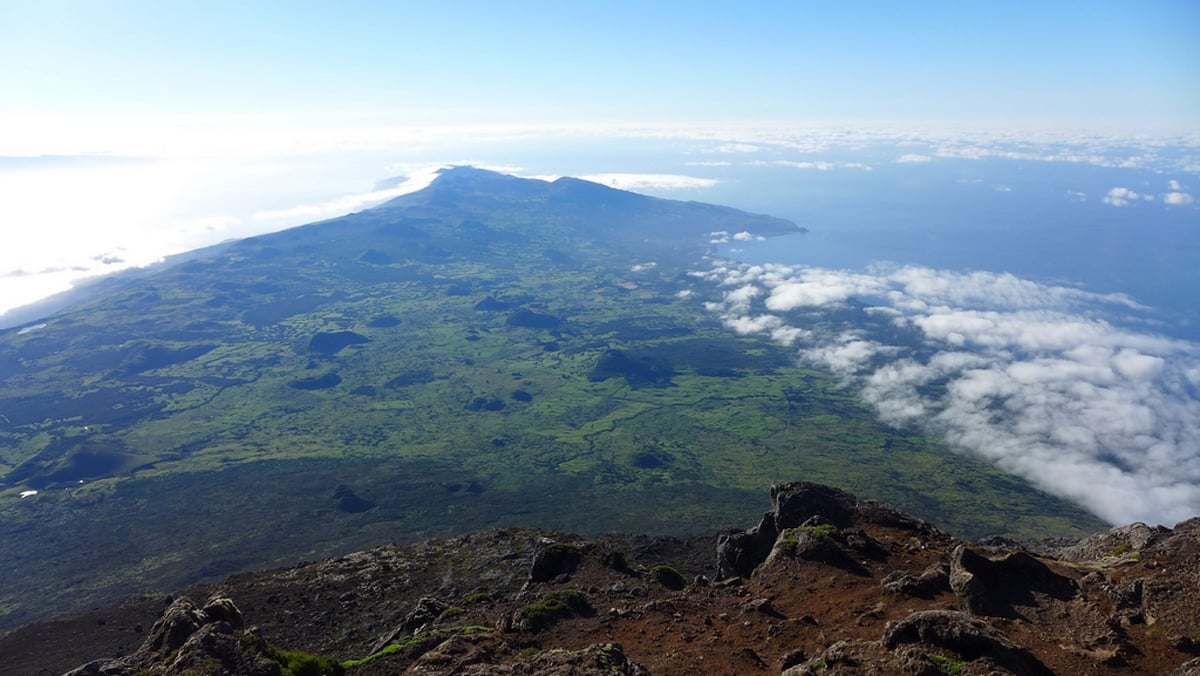
To climb the highest point of the Azores, the Pico volcano, it is advisable to take a guide, although the cost of the trip in this case will be higher. Sometimes, even with marks, you may not notice the necessary turn, and the guide has a detailed map of the area. The services of a guide will be especially relevant if the ascent is made at night or if the ascent is not in a group, but on your own. It is also convenient that the guide can successfully replace the photographer, capturing a famous landmark of Portugal in the background.
Natural Park and Caldeira
On the island of Faial, covered with thickets of lilac-blue hydrangeas, there is a beautiful natural park. Almost all of its territory is occupied by a huge basin of volcanic origin. It is known as Caldeira.
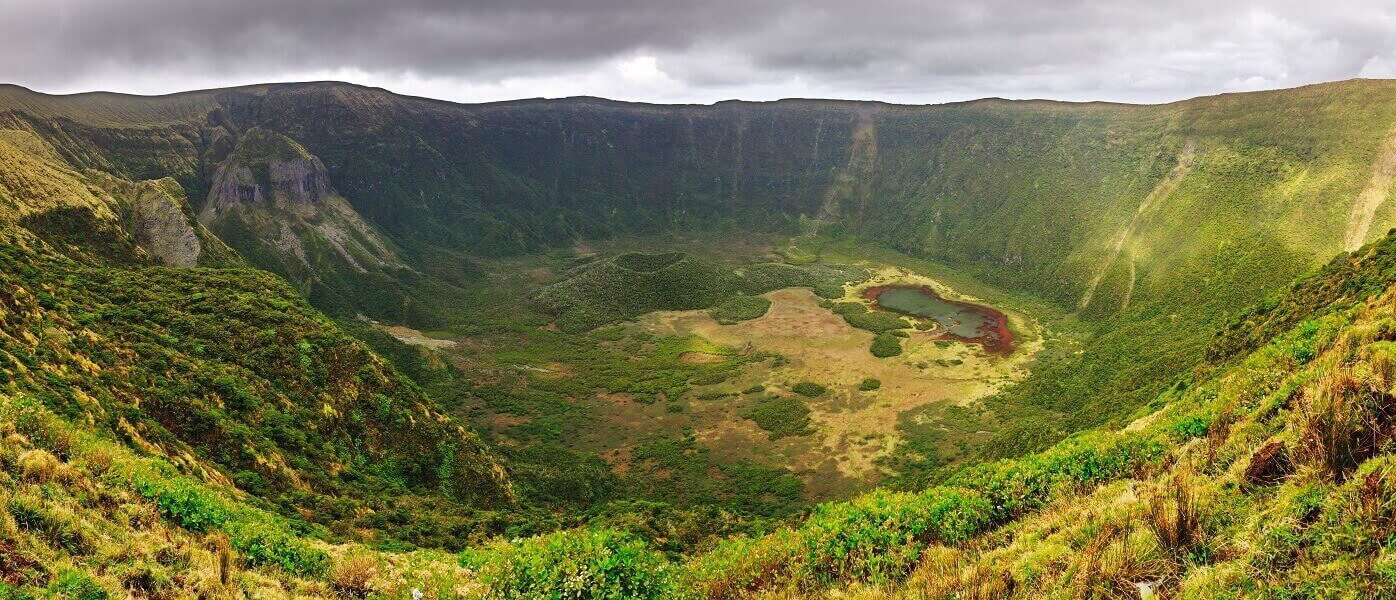
This landmark of the Azores Islands reaches 2 km in diameter and its depth is 400 m. The slopes of the Caldera are covered with impenetrable cedar forests.
There are several walking routes through these picturesque places, one of them is laid around the Caldera. But if such a route seems too long, you can see this famous landmark from the Miradouro da Caldeira observation deck.
Capelinhos Volcano
The main tourist attraction of the island of Faial is the Capelinhos volcano and the “New Land” that appeared as a result of its activity.
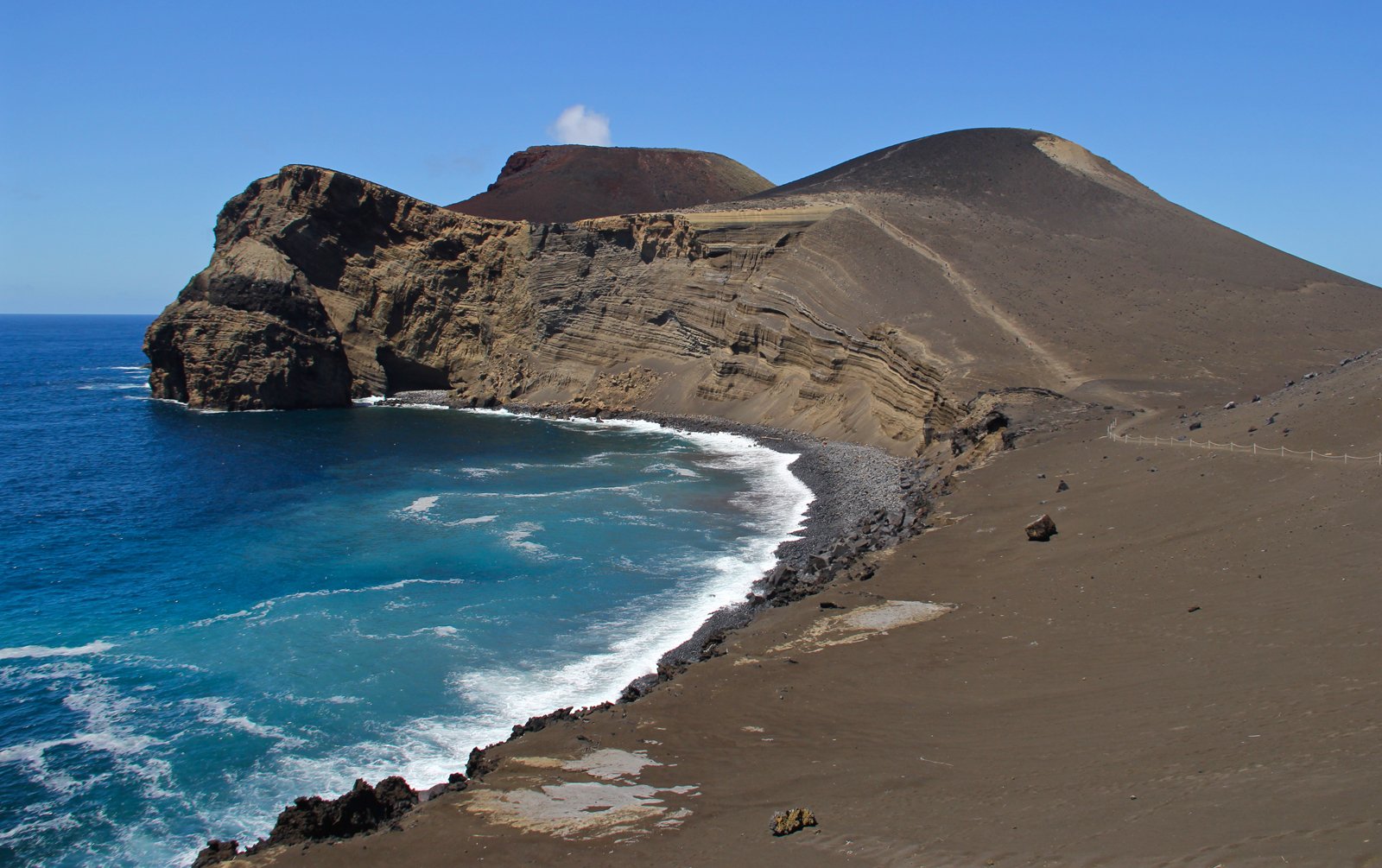
This attraction is located in the western part of the island, it takes about 40 minutes to get there from the city of Horta by car.
The eruption of the underwater volcano Capelinhos occurred in 1957-1958 (it lasted 13 months). Traces of the eruption can be seen everywhere: half-destroyed buildings covered with mountains of solidified lava, a lighthouse half-buried in ash, and also a new peninsula. Where the lighthouse stands, before the Capelinhos eruption, there was the edge of the island. As a result of the volcano’s action, a new peninsula was formed, increasing the area of Faial by 2.5 km². “New land” – this is what the locals call it.

Under the lighthouse there is a volcanology museum, the only one of its kind in Portugal. In the museum you can learn about the history of the Azores archipelago, and learn a lot about volcanism. The ticket costs 10 €, it also allows you to climb the lighthouse.
Monte Brasil
Monte Brasil is essentially a park area in the center of the city of Angra do Heroísmo on the island of Terceira. Location: R. Francisco de Ornelas n.º 12, Angra do Heroísmo, Portugal.
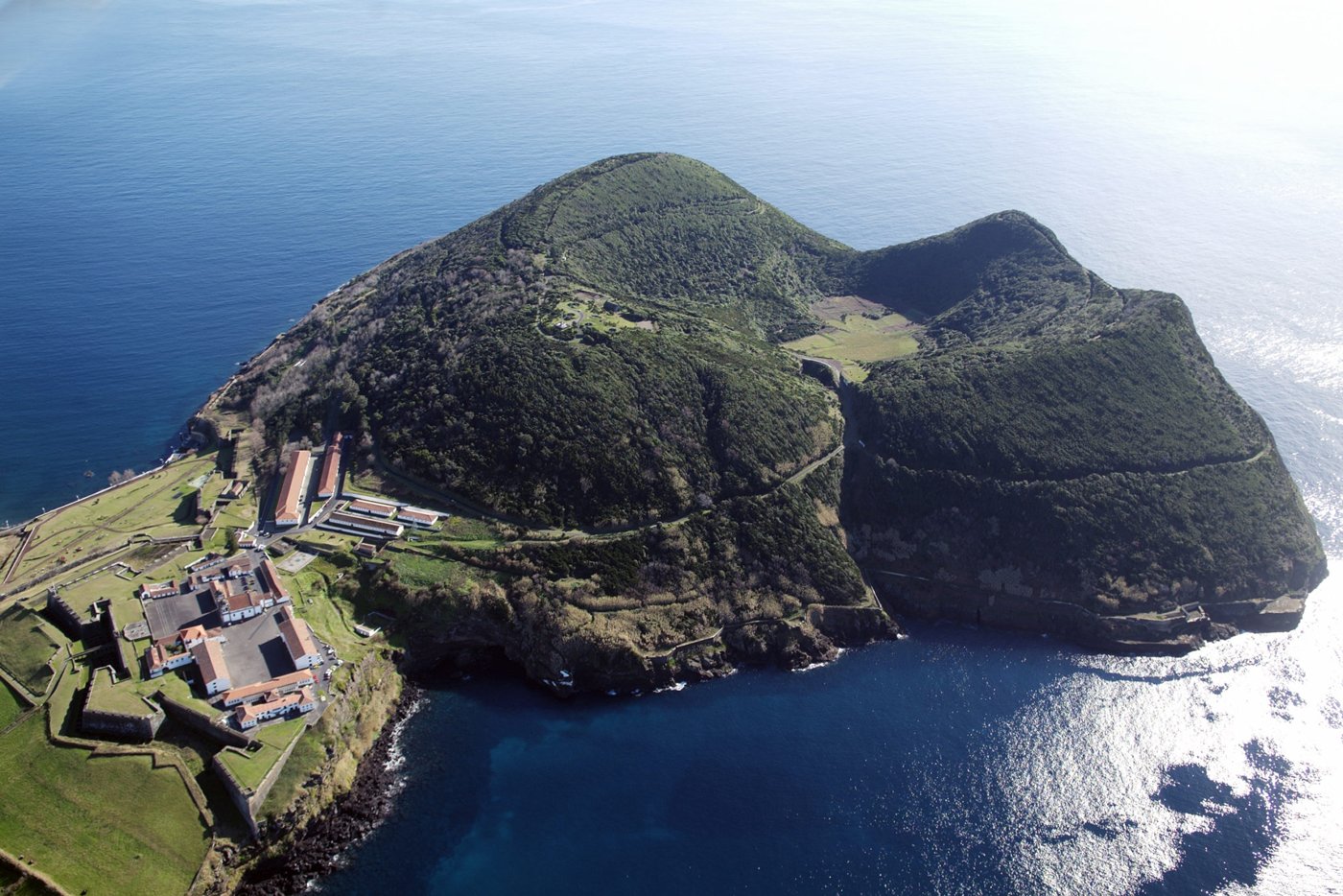
You can climb to the top by car, but it is still better to walk this way along well-prepared pedestrian paths and get the maximum impressions. At the top of Monte Brasil there is a large recreation area, a small zoo, several observation platforms. From there, a magnificent panoramic view of the city and the ocean opens up. If you are lucky with the weather, you will get beautiful photos as a memory of your trip to Portugal and the Azores.
Faja Grande Village
Flores Island is for those who love walking tours.
The village of Fajan Grande is a beautiful place on the west coast of the island. On one side it is closed by huge cliffs with lush green vegetation, on the other side – the ocean, crashing its waters on the coastal cliffs.

From this area you can see another landmark of Portugal: the small island of Monchique, which was once used as a starting point for sea navigation. Monchique is a small basalt cliff standing alone in the ocean waters, reaching a height of up to 30 m.
The exact address of Faja Grande is: Santa Cruz das Flores, Flores 9970-323, Portugal.
Holidays in the Azores: the price of the issue
Vacationing in the Azores is not as expensive as many people think. If you try, you can fly there inexpensively, find a budget hotel and eat quite economically.Accommodation

In Ponta Delgada, 3* hotels offer double rooms for an average of €100 per night, with prices starting at €80. For example, for €75-120 you can rent a great double room at the Hotel Comfort Inn Ponta Delgada.
Prices for apartments start from 50 €, for example, a good option is Apartamentos Turisticos Nossa Senhora Da Estrela or Aparthotel Barracuda. Average prices for apartments in Ponta Delgada are around 100-130 €.
By the way, it is advisable to book hotel rooms in advance, especially if the trip to the Azores is planned during the holiday season. The best deals are best found on the website booking.com.
Azorean cuisine is a rich, hearty peasant cuisine. Famous local food of the Azores includes Cozido das furnas (a one-pot stew cooked in hot springs), wine-braised octopus, cabbage soup, fried mackerel, local pineapple, sweet/spicy Pimenta da terra (cherry red peppers) and fresh, full-fat dairy products such as local yogurt, butter and cheeses. Queijo do Pico is a salty cow’s milk cheese from the island of Pico.
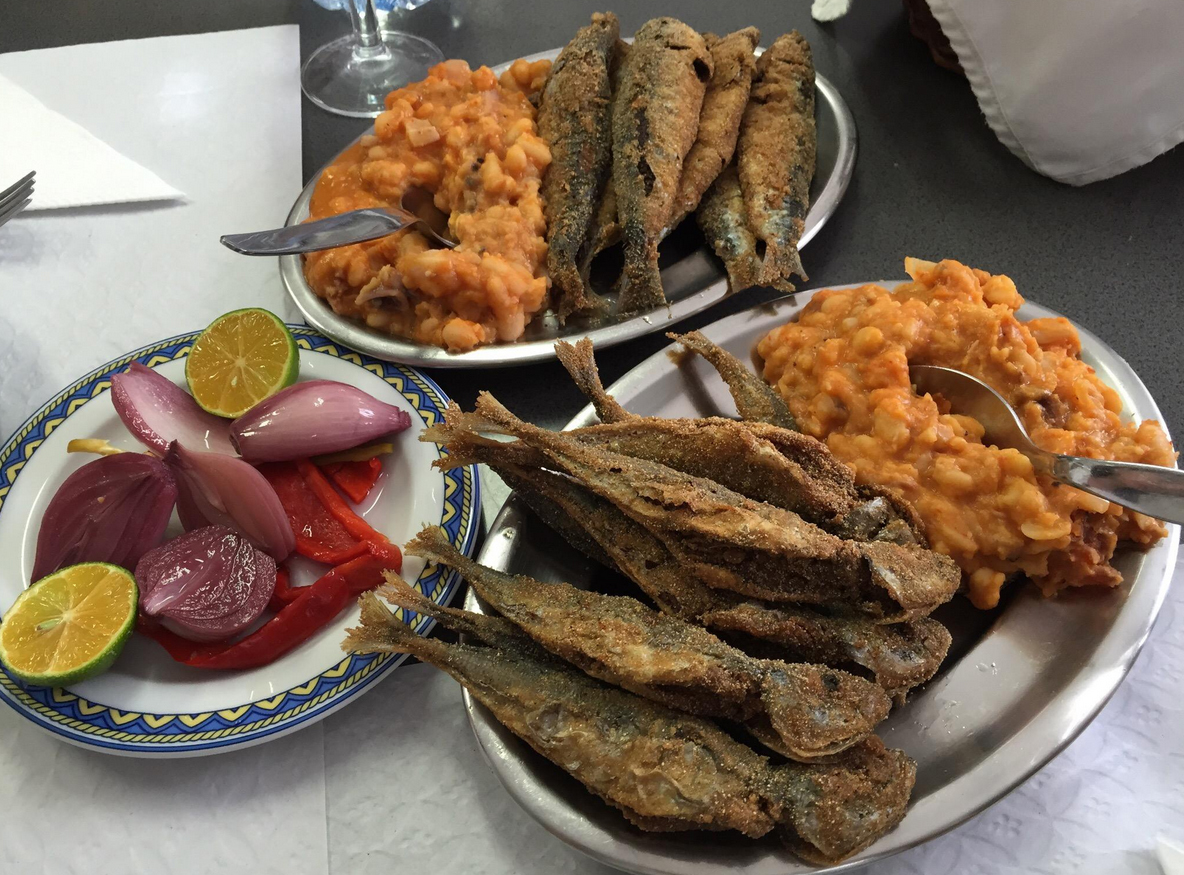
Food prices in the Azores are not much different from prices in Portugal. For example, in Ponta Delgada, in a mid-range restaurant, you can easily have dinner for two for €50, and this price includes a bottle of wine. You can eat in a cafe for €8 per person.
If you have the opportunity and desire, you can buy products in stores and cook them yourself. Below are the prices in euros for some food products:
- loaf of bread – 1.3;
- package of milk (1 l) – 0.7;
- bottle of water (1.5 l) – 1;
- eggs (12 pcs.) – 1.3;
- locally produced cheese (kg) – 10;
- fish and seafood (kg) – from 6 to 10;
- rice (kg) – 1.1.
Weather conditions in the Azores
The Azores Islands have a subtropical maritime climate.
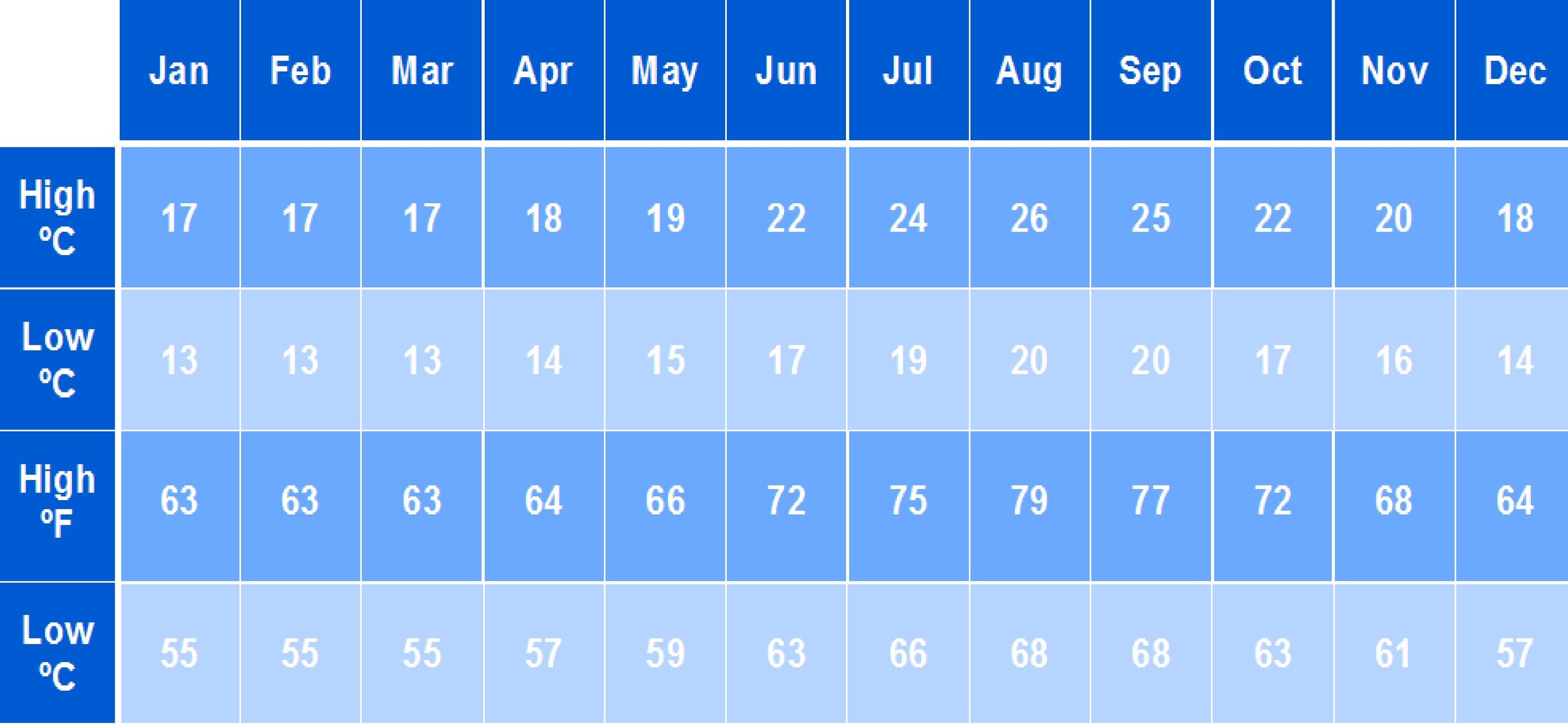
The average air temperature in the winter months is around +17 °C, and in the summer – around +25 °C, although in July and August it can sometimes rise to +30 °C. The water in the ocean warms up to approximately +22 °C in the summer.
Rains in the Azores are short-lived, they can last only a couple of hours, and mainly in autumn and spring. Summer is usually dry and clear. The close location of the Atlantic Ocean leads to the fact that the weather here is changeable – it can change several times a day.
Interesting fact: The Azores are a year-round resort. However, it is advisable to choose different times for a beach holiday and for trips to local attractions. The best season for a beach holiday is from June to September, and the spring months are more suitable for walks and excursions.
How to get to the Azores
The Azores archipelago, which is part of Portugal, can only be reached by plane. There are several airports here, but most of them are used for domestic flights, and only three have international status: Santa Maria on the island of the same name, Terceira Lajes on Terceira Island, and the largest, Ponta Delgada on Sao Miguel Island.

There are no direct flights from Eastern European countries to any of the named airports, so you have to fly with a transfer in the capital of Portugal, Lisbon. In 99% of cases, tourists arrive at Ponta Delgada Airport, from where there are regular flights to all the islands of the archipelago.
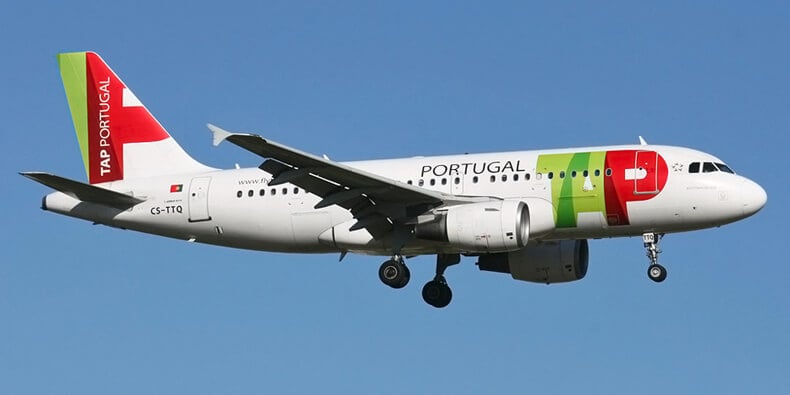
There are no problems with getting from Lisbon to the Azores. There are direct flights twice a day from the capital of Portugal to Ponta Delgada, the flight lasts from 2.05 hours to 2.30. A ticket can cost from 20 to 220 €, or even more – it all depends on the airline (Tap Portugal, Sata International), time of year, day of the week, etc.
At Lisbon Airport, domestic flights to the Azores depart from the small Terminal 2, which can be reached from Terminal 1, which receives international flights, by a free shuttle bus (it runs every 5-7 minutes).

